
copyright 2009 by George Johnson
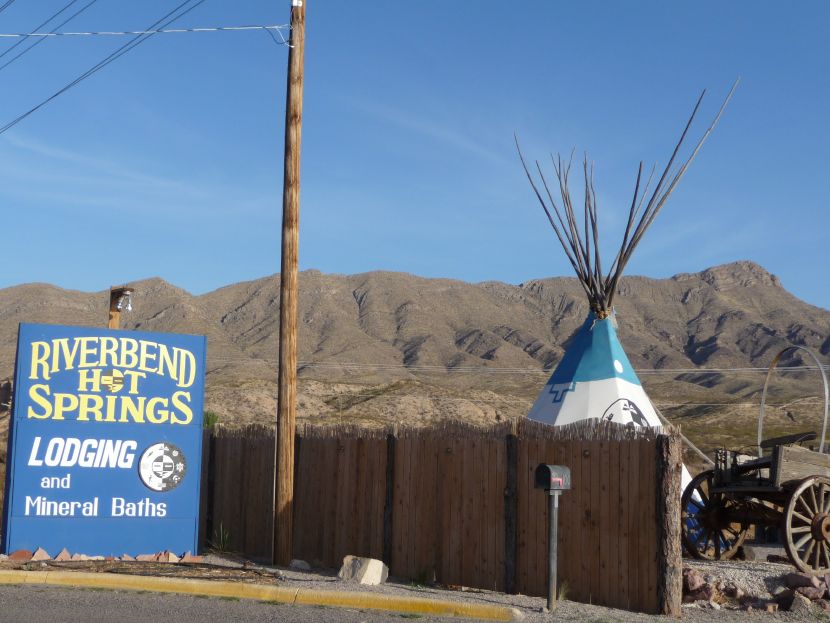
Truth or Consequences, New Mexico. photos by George Johnson, copyright 2009
1. Retrofit Arithmetic (and Rainbarrel Economics)
2. The San Juan-Chama Shell Game
3. The Case of the Disappearing Aquifer
4. The Creative Hydrology of Suerte del Sur
5. The City, the County, and a Water Tax Revolt
6. Water Numerology at City Hall
(Our story thus far)
7. The Woman at Otowi Gauge
8. "Forget it, Jake. It's Chinatown."
9. The Las Campanas Connection
(Our story continues)
10. The Engineering Solution
March 28, 2009
59. Truth or Consequences
Ten days ago on my way to southern Arizona for a night of galaxy gazing at the Vatican telescope on Mount Graham, I stopped in Truth or Consequences, New Mexico, a town so desperate for recognition that in 1950 it sold its soul to a game show. I'd never spent much time there, so after checking into a motel I drove down to the city park and walked along the Rio Grande.
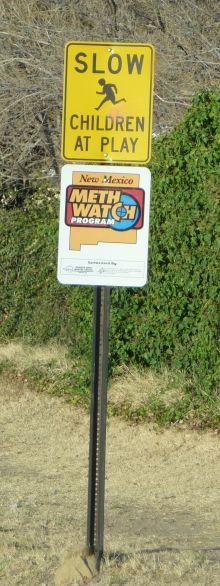
A few of the spas have gone New Age, offering aromatherapy, reflexology, and other quack cures. People have long been drawn to T or C for their health. Along the main drag, Date Street, a rusting blue sign with a pair of human lungs advertises Respiratory Services. On a bluff overlooking the town, the old Carrie Tingley Hospital for Crippled Children, which used to treat polio victims with the region's soothing waters, has been replaced by a veterans home.
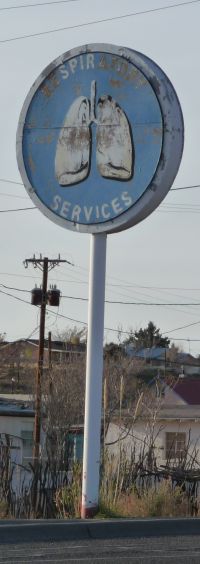
As the sun was setting I drove along Riverside Drive -- rural, idyllic, and marked every mile or so by signs for a program called New Mexico Meth Watch. I thought about the TV series "Breaking Bad" where an Albuquerque high school chemistry teacher operates a methamphetamine lab. T or C has long been a cheap place to retire and park a trailer. Maybe cooking crystal in your Airstream has become another way of supplementing Social Security and Medicare.
The next day I headed west through the old mining town of Hillsboro and then over the Black Range to Silver City and finally Mount Graham. After a night at the observatory (grist for a future Science Times story) I continued on to Deming to meet up with an archaeologist for a drive south to the ruins at Casas Grandes, Chihuahua. Getting out of the United States was harder than getting into Mexico. At the Palomas crossing an American border guard interrogated us about our destination and whether we were smuggling automatic weapons or bundles of cash. We just said no. The Mexican border guards perfunctorily stamped our papers and waved us through.
Several people in Casas Grandes told us how the region, which has been trying to promote itself as a tourist destination, has been hurt by the drug wars. Americans read about the murders in Ciudad Juárez and are afraid to go to more peaceful towns like Casas Grandes. One resident praised President Calderón for calling in the army to quell the violence. Another insisted that the army is just another arm of the narcotics cartel.
On the way back to the border we were stopped at a road block and searched for drugs by Mexican soldiers so young they looked like school boys. While they tapped at my car trying to sound out hidden chambers, I looked at snapshots of recently seized contraband posted on a roadside bulletin board. A day later, back in the United States, I read about Hillary Clinton's diplomatic mission to Mexico and her promise to seize more of the weapons the United States has been illicitly exporting for use by the drug traffickers.
It's about time. American demand feeds the drug trade, and the people of northern Chihuahua are suffering from the violence far more than anyone on this side of the border.
March 30, 2009
Sun Mountain
Sunday morning I walked across the campus of St. John's College to the trail behind Weigle Hall that leads to the top of Sun Mountain. I hadn't been there for awhile, and I hoped I could hike high enough to see the site, about a mile north, where contractor Doug McDowell is building an estate for the wealthy fashion designer Tom Ford. Mr. McDowell recently announced plans to "reinvent" himself as a developer, and his first project is a subdivision on the side of Sun Mountain. The short trip to the summit seemed like a good way into the story.
When I reached the top I saw that the view of the enormous Ford compound was obstructed by Sallie's Hill. Sallie Wagner, an old Indian trader, was one of those rare people who resisted the notion that she who dies with the most stuff wins. Instead of chopping up her hill and maximizing the amount of developable real estate, she created a 19.5-acre conservation easement. An important piece of Santa Fe's skyline was saved. Even so, she left her descendants with a substantial inheritance. Her house and the surrounding acreage, protected by the restrictions, was listed for sale last year for almost $2.5 million.

Sun Mountain is not so fortunate. On the southwest slope Mr. McDowell intends to subdivide 23 acres that was once home to the late John T. Watson, a former state Supreme Court Justice and champion of historic preservation. For years people driving along Old Santa Fe Trail have seen the sign with the painted letters marking his driveway. (When you drive in the opposite direction, the letters are reversed.) Now, according to the New Mexican, Judge Watson's heirs -- they include Mac Watson, who followed his father as a historic preservationist -- have provided Mr. McDowell with an option on the land. Judging from his comments to the New Mexican, he has persuaded himself that building more houses there is an eco-friendly thing to do.
We all know we are going through a huge change right now [he said] and the era of the big house is probably over to some degree. What we need to be doing now are green homes and sustainable homes, energy-efficient homes.
No, what we need to be doing is resisting the impulse to subdivide what little remains of the foothills and erecting rows of greenwashed spec houses to dump onto the real estate market.
As the ground beneath my feet grew muddier from the melting snow I tried to imagine this area before the developers arrived. A little farther north on Old Santa Fe Trail, near where it crosses the bridge over the Arroyo Chamiso, I could see the big rock house that belonged to Judge Watson's neighbor, the architect John Gaw Meem. Meem discovered the area when he was a patient at the Sunmount tuberculosis sanatorium at the end of Camino del Monte Sol. (It is now the Immaculate Heart of Mary Retreat and Conference Center.)
Like Sallie Wagner, Meem was a mutant, lacking the subdividing gene. He donated the land that became St. John's College, and the property he kept belongs now to his descendants, who include our state representative, Peter Wirth. There are still hundreds of empty acres between the old Meem and Watson places. They too, I suppose, will someday come onto the chopping block.
We'll hear more about the supposed benefits of the Sun Mountain deal -- four of the 16 houses will be "affordable" -- at an Early Neighborhood Notification meeting Wednesday at 5:30 p.m. at the Santa Fe Woman's Club on Old Pecos Trail. It will be conducted with the help of consultant Jennifer Jenkins, the go-to person for sugar-coating obtrusive development projects and pushing them through the city planning process.
I've written favorably here before about the consideration Mr. McDowell has shown neighbors during construction of the Ford mansion. It's disappointing to see him playing the developer's game.
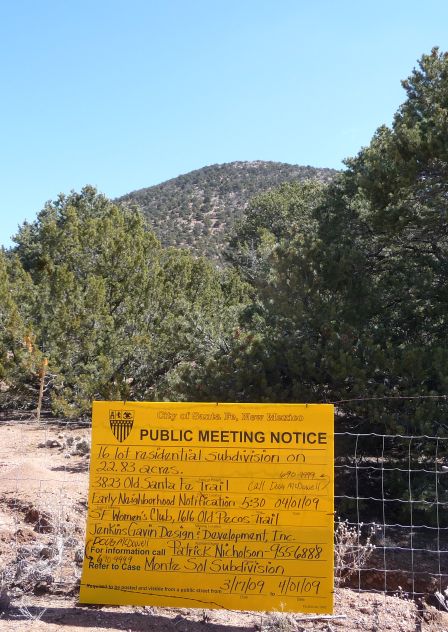
April 8, 2009
Derailed
It was depressing to learn a few weeks ago that one of the first tenants at the new Railyard development's forlorn Market Station will be a Verizon cellphone store. If things get much worse, maybe we can look forward to a Tai Kwon Do parlor and a fundamentalist storefront church. For now developers at the Railyard, once heralded as the new Plaza for Santa Fe locals, are counting on the arrival of four more restaurants. But I wonder how many will go forward with their plans. The New York Times recently quoted a restaurant industry consultant who predicts that at least 20,000 eateries will go bust nationwide over the next three years.
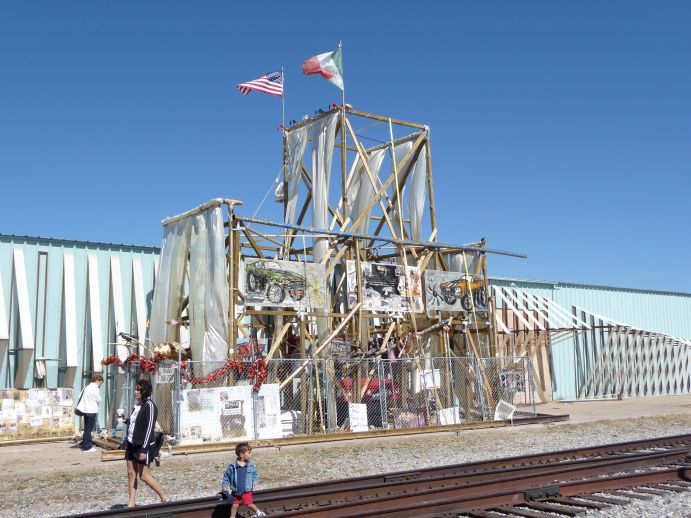
I bet Flying Star won't be among them, and the company's imminent arrival at the Railyard is one of the few bright spots. I went to college with the owners, Jean and Mark Bernstein, art students who were making a living running a part-time janitorial service out of the back of a van. Now they are successful restauranteurs, and they became so by paying their employees well and offering benefits almost unheard of in the restaurant business. The result is service by intelligent people who seem genuinely glad to be doing a good job.
Compare that with Zia Diner, which will be one of Flying Star's closest competitors. The owner of Zia did everything she could to keep Santa Fe from enacting a higher minimum wage. Recently Zia's menu has been cut back to basics, and the restaurant is losing its appeal. When I've been there lately tables were going begging. It will be a struggle for the place to survive the opening, just a few blocks away, of a humane, high-quality operation like Flying Star.
Almost the only discretionary spending thriving these days is on movie tickets, as people seek a reasonably inexpensive way to hide from the Depression in fantasyland. But the Railyard has lost its chance to benefit from the trend. Years ago, it had the opportunity to strike a deal with Richard Brandt, a Santa Fean who knows more about running a movie theater than just about anyone in the country (he was chairman of the board of Trans-Lux). Instead the contract went to Maya Cinemas, a small California company that announced ambitious plans 3 1/2 years ago "to build six, seven facilities with 14 to 20 screens a year to get around 500 screens." Since then it has managed to open just one theater, in Salinas. A second opening in Bakersfield has been indefinitely postponed. And Maya Cinema Santa Fe remains a muddy hole in the ground. No one has explained why excavation was allowed to proceed before Maya secured financing.
Meanwhile from its new headquarters on the far edge of town, Thornburg Mortgage finally announced its bankruptcy, with both Santa Fe dailies digging no deeper than the Thornburg party line: that it was a solid, brilliantly managed company that was a victim of circumstances. The only reporter to question the dogma is Corey Pein, whose article this week in The Reporter is the best and most thorough that has been written. But there are still so many unanswered questions.
April 22, 2009
While in Cambridge, England last week, missing what I hear was a magnificent April snowstorm, I checked the Santa Fe newspapers online and read the Journal's credulous report on the new Thornburg campus. As Chairman Thornburg escorts members of the media around his half-deserted headquarters, we're offered a cheery assessment that might have been written by Suzanne O'Leary Lopez, the Thornburg Mortgage publicist who recently lost her job when her over-leveraged employer collapsed under its own dead weight. The grand opening, we're told with breathtaking understatement, was "tempered somewhat" by the bankruptcy of the company, which was "ensnared" in the mortgage meltdown. The reason for this grave injustice? "Unlike [for] banks," the article explains, "there was no government bailout for mortgage companies." As if government bailouts should be an expected component of any financial company's business plan.
The campus was underwritten by subsidies from county taxpayers after Thornburg was "forced" (the Journal again) to seek industrial revenue bonds because of expensive delays caused by pesky neighbors. (They were trying to enforce covenants specifically drafted to protect the residential character of the area.) Given the low intensity of journalistic curiosity in Santa Fe, that is probably the last we'll hear of the story.
April 23, 2009
Loch Ness Monsters
I'm spending the night in Inverness, the pleasantly seedy capital of the Scottish Highlands (and gateway to Loch Ness), where the big news this week is an infestation of seagulls. They "splatter their droppings over Inverness's buildings, scavenge the streets for food and even intimidate shoppers," the Inverness Courier reports. A city councilor says the birds pose a threat to the town's "emerging street cafe culture," the only sign of which I noticed was a young woman bent over in an alley outside a pub vomiting into a garbage bag while her boyfriend held her up by a belt loop.
Another item in the paper, "Luxury flats up for grabs as developer goes bust," describes the perils of a real estate project on the River Ness. It was financed on the theory (this will sound familiar to Santa Feans) that people were clamoring to buy condominiums over downtown storefronts. One of the principals in the deal was a company called Funky Urban Concept.
The developers here are apparently used to getting their way. Next to my hotel, the Royal Highland (est. 1856), is a recently constructed shopping mall where, I learned from the Courier, a man collapsed and died of a heroin overdose, not far from the Laura Ashley and the Pizza Express.
As I sat this evening in the hotel lobby -- there is a stag's head on the wall and a tartan green staircase -- a guest hobbled with a cane to the reception desk and asked for an ambulance. She was complaining of abdominal pains. Shortly after the medics escorted her to the emergency room, a drunk staggered in and collapsed on a chair.
"It's not your hotel, is it?" said the policeman when he arrived. "Had a bit to drink?"
"Up on your feet please," said the other officer. "If you refuse you'll be arrested. Would you like a hands up?"
Throughout all this a well-dressed man in an easy chair never looked up from his laptop.
The graffiti problem here is not nearly as bad as in Edinburgh, where historic gravestones have been defaced with spray paint. But another piece in the Courier reports on a spike of crime by children, including a nine-year-old rapist. "What we are seeing is a symptom of a sick and broken society," said the chairman of Inverness's crime prevention panel.
Tomorrow I'm off to the Isle of Skye, which I hope will feel more remote.
May 2, 2009
Stornoway
There was a McDonald's and a Subway in Inverness, but by the time I crossed the bridge onto the Isle of Skye, the metastasis had stopped. I've wanted to visit the island ever since the early 1990's when I saw an old black-and-white movie about a young Englishwoman arriving in Inverness by night train from London and entering another world. I vaguely remember that she was there to marry, sight unseen, a Scotsman, and that there was some legend/superstition about counting the number of roofbeams above your bed and making a wish. I'd love to see the film again if only I could remember its name.
After four relatively sunny days in Edinburgh and Inverness, Skye was cloudy and rainy and seemed, with all the tourist attractions, about as exotic as the Wisconsin Dells. After a visit to Dunleavy Castle and a night in the island's capital, Portree, I boarded a ferry to the Outer Hebrides. Landing in Tarbert on the Isle of Harris, I headed north to Stornoway.
Now this was more what I had in mind. There were no castles with gift shops, educational videos, and £10 entrance fees -- just rolling hills of thistle and peat and mountains of Lewisian gneiss, some of the oldest rock on the surface of the planet. The roads, so poorly marked you were never quite sure where you were going, would narrow unexpectedly to a single lane, but it didn't much matter. There were more sheep to watch out for than cars.
Stornoway wasn't entirely untouched. There was a Tesco (the United Kingdom's Walmart), a Boots pharmacy, and a Superdrug. But for the most part downtown looked frozen in the 1950s. There was a hardware store, a barber shop, a newsstand, a florist, and a bakery. A small department store displayed ladies' hats in the window. As in Inverness an old Woolworth sat vacant with nothing to offer except the space inside.
Walking around town I passed a young woman speaking animatedly on a cellphone. Frustrated by something she heard on the other end of the line, she exclaimed and did a little dance. "Sorry," she said, embarrassed when she realized a stranger had seen her. I was offered a similar apology, nice but unnecessary, by two little girls who were acting up as they got into the family car. I thought of them that evening when I read a letter in the Stornoway Gazette from a Londoner who had spent time in the town and wished to compliment the citizens on their rare civility and on how well-behaved their children were.
I wonder how long that will last. On Saturday night I passed a group of teenagers hanging out on the street. "What's up, Einstein?" said a short fat boy with a crewcut. They all giggled and then were flustered when I stopped to chat.
"Why do you think I look like Einstein?" I asked. The fat boy mumbled and looked at his shoes. Another boy asked where I was from. Santa Fe, New Mexico sounded so far away. "Take me with you," said the fat boy. "There is nothing to do here," said the other -- the familiar lament of the unimaginative.
As I wished them a good evening and continued up the street, two large men were coming out of a fish and chips next to a bible church and eating from a paper bag. One of them was wearing a red dress and an earring. As I contemplated the impossibility of categorizing the world, the same herd of kids come walking my way. "Hi, Einy," said the fat boy, undeterred. "E = MC squared," I replied.
Almost everything on the island was closed on Sunday. If you ran out of gas you would be marooned for a day. With almost half a tank left in the rental car, I drove along the western coast of the Isle of Lewis to see some of the old Stone and Bronze Age ruins. At Gearrannan, a restored village of thatch-roofed "blackhouses," the caretaker, who also operated a small museum, said she had moved to the island to escape crime and other urban pestilences. Even Stornoway was too big. People lock their doors there, she said. She was intently following the latest news on the swine flu pandemic -- another good reason she was glad to be on an island.
Later that day as I walked among the Standing Stones of Callanish, slabs of that Lewisian gneiss placed with great difficulty in a gravity-defying stance, I wondered about the ancient people who lived in this bleak but beautiful place. Why would anyone chose to move here? It's as if people just appear randomly from some kind of spontaneous generation. Then wherever you are you deal with it.
The next day I took the ferry to Ullapool on the mainland of Scotland. When I told the white-haired woman volunteering at the museum that I was from Santa Fe, New Mexico, she recoiled, afraid that I might be carrying swine flu. Later at the airport I watched the TV monitors with their overwrought reports. Already 80 dead in Mexico! (out of a population of 110 million). As I write this, a few days later, the toll has dropped to 16.
Coming next: Back to Santa Fe
A Special Report: The Mysterious Destruction of the Santa Fe Indian School
The Andrew and Sydney Davis Webcam
Who Owns the Plaza? (this may take a minute or so to load)
A Stroll Along Shirley MacLaine Boulevard
The Santa Fe Review
More links:
See the current flow of the Santa Fe River above McClure Reservoir
with
the USGS automated gauge.
The Otowi
gauge shows the flow of the Rio Grande north of Santa Fe.
Santa Fe water information, a collection of documents and links

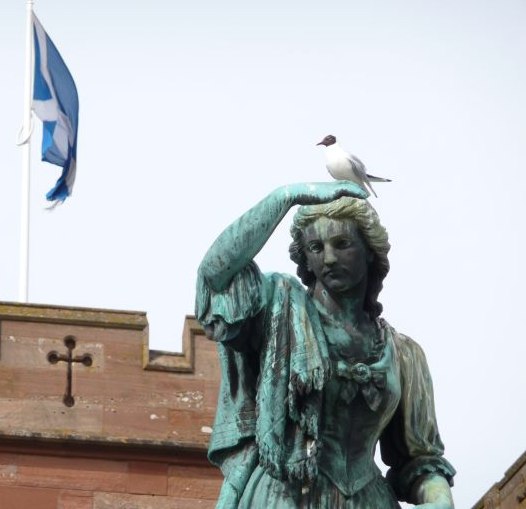
Statue of Flora MacDonald, Inverness
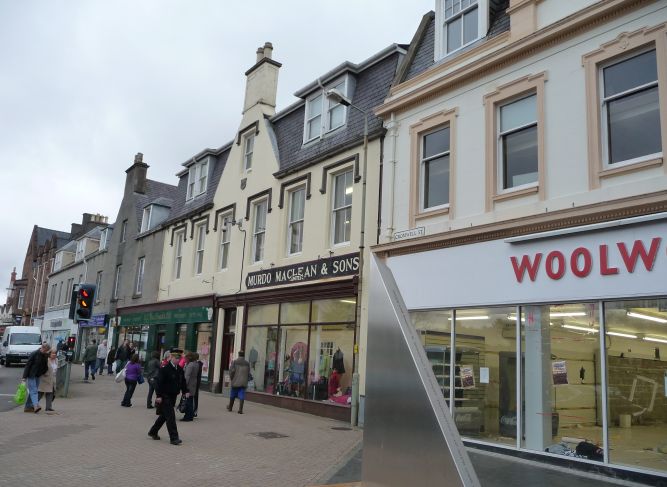
Stornoway
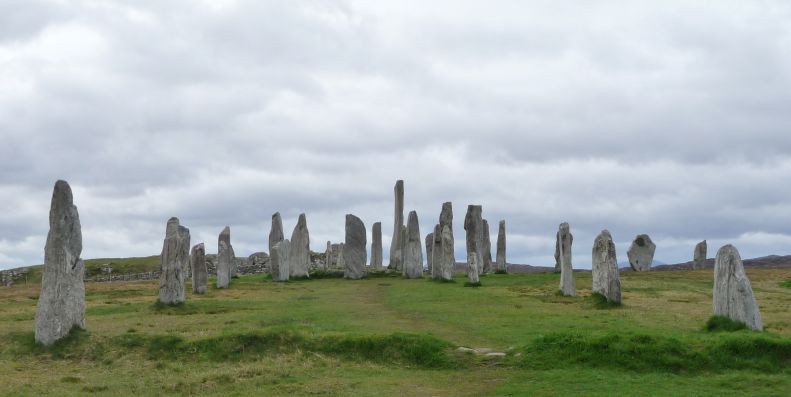
The Standing Stones of Callanish
